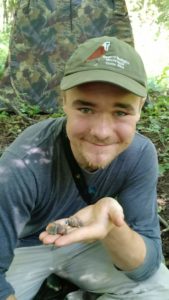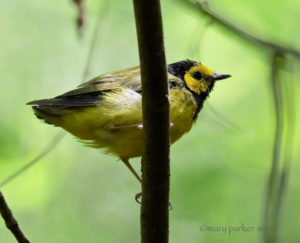Birds of a Feather
Allegheny College Professor, Student Partner To Study Songbirds’ Parental Care
To Will Harrod ’21 and Allegheny College Biology Professor Ron Mumme, lab research means early morning drives and time spent among the trees. Their eyes stay fixed not down into a microscope, but up into forest branches. Their muse? The hooded warbler.
For two summers, Harrod partnered with Mumme to conduct fieldwork following the behavioral patterns of male and female hooded warblers. This meant long, early workdays at Hemlock Hill, adjacent to Erie National Wildlife Refuge, where Mumme has been studying the warblers for over 10 years. Harrod joined the work during the summer of 2018, between his first and sophomore year.

“I was always amazed by the depth of knowledge that Ron constantly passed on to me,” says Harrod, a double major in biology and environmental science and sustainability. “Whether it was learning exactly what a hooded warbler was doing as it hopped back and forth through the brush or the history of folk music, I took in so much information from him during the two summers that we worked on this project.”
Originally, Mumme was interested in investigating how hooded warblers use the white patches in their tail feathers to startle insect prey and improve foraging success, but this soon led into a new curiosity. In the annual molt, males would desert their late-season nestlings, leaving female warblers responsible for all remaining parental care.
When Harrod joined the team, his research interest explored that curiosity. Mumme and Harrod spent a lot of hours searching for nests — “fun and usually just the right amount of challenge,” Mumme says — as well as color-banded males who had deserted the nests. They also used observation blinds and recorded video of nests to be able to watch the hooded warblers’ behaviors without startling them, and they weighed nestlings daily to document growth and changes in body mass.
“Will came to Allegheny as a gung-ho birder and budding ornithologist from Ithaca, New York, which is the home of the Cornell Lab of Ornithology and a real center of bird conservation and research,” Mumme says. “He and I shared a genuine enthusiasm for fieldwork involving birds, and he was a quick study in picking up the two main field skills needed for his project — finding nests and finding molting males, who can be retiring, skulky, and difficult to track down.”

Before coming to Allegheny, Harrod had already cultivated a love for studying bird behavior, always asking questions about why they do what they do. Mumme met him as a prospective student visiting campus and helped his inquisitive mind take flight.
“The prospect of working one-on-one with a professor at the undergraduate level was one of the main reasons that I chose to go to Allegheny,” Harrod recalls. “The chance to learn so much and contribute to the broader body of science is a rare, fantastic opportunity. Seeing this project go all the way from a question, to fieldwork and data collection, to statistics, to a published paper and a poster presentation has taught me more than I ever dreamed of learning in college.”
Their research findings surprised Mumme and Harrod in different ways. Mumme had imagined that male desertion would cause some significant problems for the growing nestlings, but found that female compensation for desertion was consistent with other species of songbirds. Not only did female hooded warblers manage to support the nestlings, they effectively doubled their parenting efforts to give the nestlings the same support as those whose male counterparts stayed, which exceeded Harrod’s expectations.
Harrod and Mumme published their findings in IBIS, the journal of the British Ornithologists’ Union (BOU), in a paper entitled “Females compensate for moult-associated male nest desertion in Hooded Warblers.” Their work has since made it to a short list of four papers nominated for the best paper published by IBIS in 2020 where the lead author is an early-career researcher (ECR). Open voting ends March 8; vote here.
You can read their paper here or their co-authored blog post on the BOU Blog here.